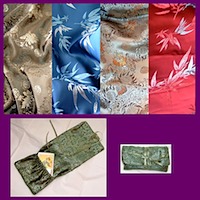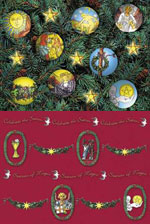By Jeanne Fiorini
People who’ve taken my Introductory Tarot class have three major concepts burned into their brains by the end of the course:
- The Tarot is a system in which each of the 78 pieces is an indispensable part of the Whole. The good, the bad, and the ugly: it’s all in there and it’s all necessary. You don’t get one without all the others and you don’t get far without accepting the entire package.
- The opposites of existence (light/dark, masculine/feminine, sun/moon, activity/passivity) are in constant play at all times.
- Change is intrinsic to the system … perhaps due to concepts #1 and #2. Nobody gets out alive and no one gets the luxury – or the curse – of avoiding the forces of change.
There are several cards representing these forces of change in the Tarot deck, but those having the most significant impact are the Wheel, the Death, and the Tower cards. We have no choice but to bend in the face of any of them, but degrees of flexibility and intensity do exist.
Do you like your changes slow and organic? Try not to take things personally, do you?
Well then, the Wheel card is for you. This is the “stuff happens” card, the “wait and see what unfolds” approach to life. Nobody can get justifiably angry when the seasons shift or when they make you leave high school after graduating from the 12th grade. It’s these types of cyclical and timing-related shifts over which the Wheel card officiates.
Problems can occur, however, when the Wheel turns on a person who has become highly attached to the old way: “But I like the warm sunny days of August…” or “I had so much fun in high school.” With the Wheel card we need to remember that the change is not personal, it’s simply time to move along; it’s best to not ask why.
The heat gets turned up when change happens in the guise of the Death card. Now it is personal and not always easy to bear. Because the degree of personal investment is higher, changes that occur with the Death card go beyond the organic, cyclical changes of the Wheel and move us into disidentification.
This disidentification is why most Death cards depict a physical dismemberment of some sort: floating body parts, people who’ve been trampled by horses, reapers with threatening scythes, that kind of thing. These images force us to look at the parts of our life which are passing away: “When I get divorced, I’ll no longer be Mrs. XYZ”
“Now that I’m an empty-nester, do I continue to be a parent?”
“When I leave my job as CEO, how will people think of me?”
“My days as a single person are over once I get married.”
These are more weighty concerns that the shifting of the seasons, for sure. The Death card drives home the point that the “you” who used to exist and move through the world is gone, and the “new you” has not yet made itself known. As a result, the degree of attachment to the old forms will be directly related to the degree of difficulty with the letting go that the Death card demands. Will you allow things to easily fall away or will you leave scratch marks in the dirt around you?
When the circle of time (Wheel card) or the natural systems of decay (Death) don’t do the trick and a more radical shift is required, the Tower card appears. If there was some modicum of choice and flexibility with the first two cards, it’s all flung out the window along with everything else in The Tower card.
The Tower depicts the take-no-prisoners kind of change: sudden, forceful, loud, and overwhelming. It is the shocking awareness of seeing what we didn’t/couldn’t/wouldn’t see before. It’s the piercing of the veil of illusion, the “blowing off the lid” from a reality whose time has expired. Not always “bad,” but not very pleasant, and often quite messy.
It’s the pink slip in your inbox when all the while you’ve been secure in your job. It’s the spouse who wants a divorce after two years of what you’ve considered to be a happy marriage. It’s the spiritual experience that happens in the middle of the produce aisle. It’s the beautiful day in September that you assumed would be like all the others.
The positive aspect of the Tower is to be able to recognize that from which we have been released, what structures we are being forced from: our denial, our narrow perspectives, our self-made prisons, our selfishness, our limited belief systems. The Tower breaks down the walls and sets us free, and while it often isn’t enjoyable it can be a most transformative experience.
In the face of such perceived chaos, and along with the acknowledgement of the profound effects of change, the Tarot provides keys to help us find our way. In the Wheel card, along with whatever apparent randomness is depicted, you’ll find a center point: the center of a cart wheel, the center of the zodiac, the center of a web. This reminds us that in uncertain times it is essential to hold on to what is constant, i.e. who you are at your core, who you always were and always will be, regardless of the particular aspects of your life which may be changing.
And while there is dismemberment and decay in the Death card, there are concurrently and consistently appearing images of renewal: a rising sun, a sprouting leaf, and red rose, a green pasture on the far side of the river. The reaper’s scythe itself resembles a crescent moon, an ancient image of death and rebirth.
The Tarot’s survival key for the times of disidentification is the fact that old life always gives way to new life. The Death card is the ultimate compost pile, the disposal for outworn forms and a place where they may become revitalized and readied for reuse, and we are again reminded that The Circle continues in ever-evolving forms and patterns As Albert Einstein stated, “energy can neither be created nor destroyed.”
The Tarot offers us the gift of freedom with the Tower card. Could you imagine that the people on this card are flying out of the windows rather than falling perilously to the rocks below? Can we be wise enough in the midst of such a transition to seek creative ways to re-establish order from a newfound perspective, while not falling backward into old habits?
The futile action here would be to reconstruct what has fallen, simply because of its familiarity or our comfortableness with it; because it’s all we’ve ever known. It is as if a potted houseplant’s roots had grown and expanded in such a way as to cause the pot to crack. A container that had once provided a secure space for growth and nourishment is no longer suitable. The plant can’t live long (or well) in the repaired and leaky pot, but would thrive if provided with a larger container and some new soil. If the Tower card has appeared in your life, get a new pot!
An important clue to the significance of the Tower (Card #16) and its attendant and requisite shift in perception is indicated by the card that succeeds it in the series, the Star (Card #17). If we must recreate a life from the shattered pieces of what we thought we knew, this card of hope exhorts us to “think big and believe largely” as we re-imagine what is possible for our future.
We cut ourselves off from all that we are capable of being when we resist the inexorable forces of change. Sometimes change comes along nice and easy, and sometimes it shakes us to the core. But there certainly is no avoiding it, and with it comes vast opportunities for enlightenment and transformation.
So the question becomes not “will my life change?” but rather “how can I best work with change as it enters my life?” Beyond the fallout of the Tower, the Star card encourages us to be brave (and creative) in times of transition. Not to rail against change, but as Bobby Kennedy mused, to “dream things that never were and ask why not."


